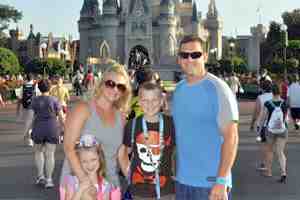Subscribe Now: 1 Full Year of DLR For Only $12.97!
Get full access to the DLR Crowd Calendar, Lines Mobile App, Touring Plans and More!

"Our TouringPlans subscription was a lifesaver on our trip. One of the busiest days of the year, and we never waited longer than 20 minutes!"
- Smith Family, KY
Adventureland is the first "land" to the left of Main Street and somehow manages to seamlessly combine South Pacific island, Middle Eastern bazaar, and African safari themes. Transitions from one part of Adventureland to another feel quite natural, and the identity crisis inherent in the mixed-theme cocktail never registers in the minds of most guests. Space is tight in Adventureland, however, making for some of the worst pedestrian congestion in any of the Disney theme parks. If you’re just passing through Adventureland, say on your way to Splash Mountain, you can avoid the congestion by transiting Frontierland instead.
Attractions
Also in Adventureland...
As we saw on Main Street, a highly visible design concept is called a "weenie" in Disney-speak. This architectural object, usually moving, acts like a beckoning hand and draws the guests to where the Imagineers want them to be. Adventureland is the only land off the Plaza Hub that does not have a weenie. Why? Well, if you could see where you were going it would not be much of an adventure, right?
Adventureland's architecture and landscape treatment blends African, Asian, and Polynesian influences but the land does not represent a specific locale. It is a kind of Hollywood ideal of an exotic place as seen through the lens of the early 1950s.
I say "Hollywood ideal" because Adventureland is largely the brainchild of Harper Goff. Harper met Walt Disney when they both bid on the same model steam locomotive in England. Walt got the locomotive but Harper got the job to design Adventureland. Harper was a set designer for the 1951 movie African Queen, which is frequently cited as a major influence in the design of the land. (Harper also worked on the 1942 classic Casablanca.) Goff's goal for Adventureland was immerse you within the exotic jungle of your (cinematic) dreams.
As you enter Adventureland, you have to turn the corner before the entire land is revealed. Using a deflected view adds a sense of mystery. The path narrows, making the experience intimate and almost claustrophobic. In addition, the landscaping is dense and seems to be overtaking the structures. Take a look at the Jungle Cruise boathouse, for example, as it is slowly reclaimed by the jungle.
Another great spot is the lanai in front of The Enchanted Tiki Room. A lanai is a Hawaiian term for an open roofed porch or veranda. In urban design, the lanai represents a sort of semi-public/private space where there is some interaction with others but it is limited. There is a terrific pre-show that features Tikis that come to life.
The theming continues underfoot. A lot of attention was paid to making the pavement rough to simulate the texture of harden earth. When modern touches are necessary, such as lights, speakers, and exhaust vents, they are hidden within the architecture. For example, there is lighting equipment cleverly hidden in the drums on top of the Dole stand in front of The Enchanted Tiki Room.
Adventureland is filled with little details that usually get overlooked. As you walk around, notice all of the small tributes to Indiana Jones stenciled on the packing crates. Just above the Adventureland Bazaar is a tribute to Harper Goff. Among his many talents, Harper was the banjo player for the Dixieland band made up of studio artists called the Firehouse Five Plus Two. His tribute is, appropriately enough, banjo lessons and Oriental tattooing.
Dining
- Bengal Barbecue (Quick Service)
- Tiki Juice Bar (Quick Service)
- Tropical Hideaway (Quick Service)
- Tropical Imports (Quick Service)

